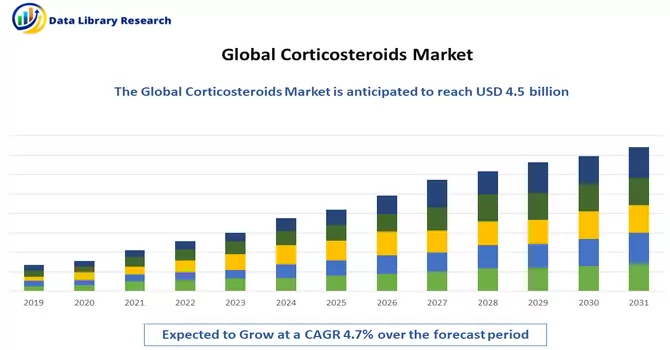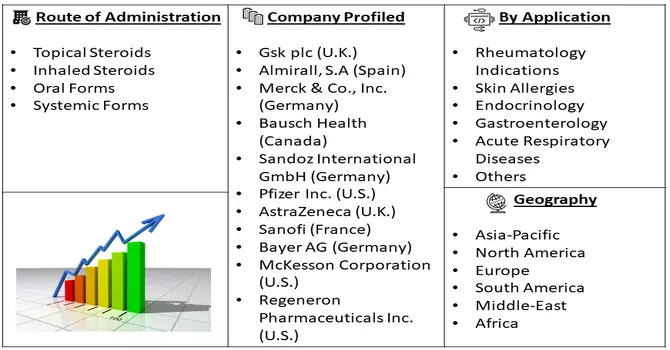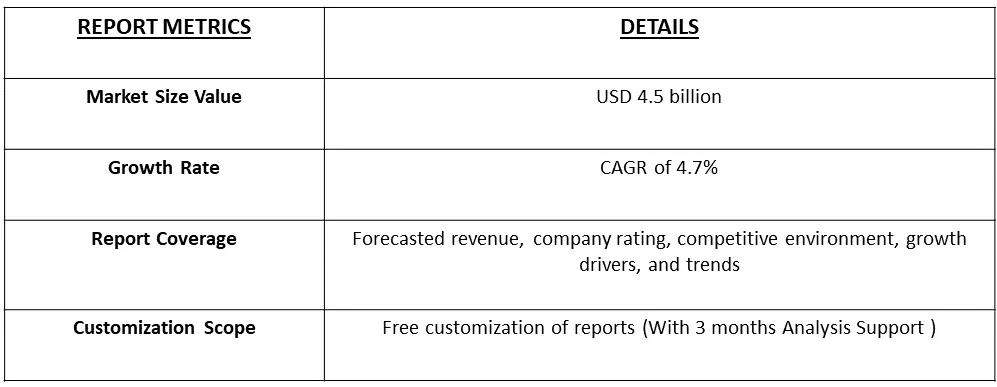The global corticosteroids market size is expected at USD 4.5 billion in the year 2023 and is expected to register a CAGR of 4.7% over the forecast period, 2023-2031.

Get Complete Analysis Of The Report - Download Free Sample PDF
Corticosteroids, also known as steroids, are a class of steroid hormones naturally produced in the adrenal cortex of vertebrates, including humans. These hormones play a crucial role in various physiological processes, such as metabolism, immune response regulation, and the maintenance of electrolyte balance. There are two main types of corticosteroids: glucocorticoids and mineralocorticoids. Glucocorticoids, such as cortisol, are involved in regulating metabolism and suppressing the immune system's inflammatory response. They have anti-inflammatory and immunosuppressive properties, making them valuable in the treatment of conditions like allergies, asthma, and autoimmune diseases. Mineralocorticoids, such as aldosterone, primarily regulate electrolyte and water balance in the body. Synthetic corticosteroids are widely used as medications for their anti-inflammatory effects, and they are prescribed for various medical conditions, including arthritis, skin disorders, and respiratory diseases.
The corticosteroids market is driven by several key factors, including the rising incidence of inflammatory disorders such as arthritis and autoimmune diseases, the expanding applications in dermatology for treating skin disorders, and ongoing advancements in drug delivery technologies enhancing the efficacy of corticosteroids. The increasing aging population, prone to inflammatory conditions, contributes to market growth, as does the prevalence of respiratory disorders like asthma and COPD. Corticosteroids play a vital role in managing allergic reactions, and their widespread use in various therapeutic areas is further fueled by the continual expansion of the pharmaceutical industry, supportive government initiatives, and growing awareness among healthcare professionals and patients. Additionally, the market is witnessing growth in emerging economies due to improving healthcare infrastructure and rising disposable income. Collectively, these factors underscore the multifaceted drivers fueling the expansion of the corticosteroids market globally.
Market Segmentation: The Global Corticosteroids Market is segmented by Route of Administration (Topical Steroids, Inhaled Steroids, Oral Forms, Systemic Forms), Application (Rheumatology Indications, Skin Allergies, Endocrinology, Gastroenterology, Acute Respiratory Diseases, Others), and Geography (North America, Europe, Asia-Pacific, Middle East & Africa, and South America). The market values are provided in terms of (USD Million) for the above segments.

For Detailed Market Segmentation - Download Free Sample PDF
The corticosteroids market is experiencing dynamic trends, characterized by a growing emphasis on innovative formulations, particularly in drug delivery methods and combination therapies. Dermatological applications, especially topical corticosteroids, are witnessing increased demand, driven by advancements in formulations and a focus on targeted treatments. Inhalation corticosteroids are gaining popularity in managing respiratory conditions due to their convenient delivery and reduced systemic side effects. The market is also witnessing a shift towards personalized medicine, exploring alternative administration routes, and expanding applications in oncology, particularly in combination therapies. Pediatric formulations are being developed to cater to the unique needs of children with inflammatory conditions. The industry is marked by strategic collaborations, reflecting efforts to accelerate research initiatives and enhance product portfolios. Increased awareness of potential side effects and safety concerns is influencing prescribing practices, and the market is expanding in emerging economies, presenting new opportunities for growth. Overall, these trends underscore the ongoing efforts to improve corticosteroid therapies, address unmet medical needs, and ensure safety and efficacy in diverse clinical scenarios.
Market Drivers:
Growing Geriatric Population and Increasing Incidence of Chronic Diseases
The growing geriatric population and the increasing incidence of chronic diseases have become significant driving factors for the utilization of corticosteroids in healthcare. With a rising number of elderly individuals globally, there is an associated surge in age-related health issues and chronic conditions such as arthritis, respiratory disorders, and autoimmune diseases. Corticosteroids, with their potent anti-inflammatory and immunosuppressive properties, are frequently prescribed for managing symptoms and providing relief to the aging population facing these health challenges. In particular, the prevalence of conditions like osteoarthritis, chronic obstructive pulmonary disease (COPD), and rheumatoid arthritis has led to an expanded use of corticosteroids to alleviate pain, reduce inflammation, and improve overall quality of life in older adults. As the demographic shift towards an older population continues, the demand for corticosteroids in addressing age-associated chronic ailments is expected to persist, emphasizing the pivotal role these medications play in enhancing the well-being of the elderly and addressing the healthcare needs of an aging society.
Increasing R&D Investments
The surging investment in research and development (R&D) has significantly impacted the use of corticosteroids, driving advancements in formulations, applications, and treatment approaches. Pharmaceutical companies and research institutions are allocating substantial resources to explore new therapeutic possibilities, improve drug delivery methods, and enhance the overall efficacy and safety of corticosteroids. This heightened focus on R&D has led to the development of novel formulations, including innovative drug delivery systems and combination therapies, aiming to optimize treatment outcomes and minimize side effects. Additionally, research initiatives are delving into alternative administration routes, personalized medicine approaches, and expanding the scope of corticosteroids in various medical conditions. The investment in R&D not only fosters innovation but also contributes to a deeper understanding of the mechanisms of corticosteroids, leading to more targeted and efficient treatment strategies. As a result, the pharmaceutical landscape is witnessing a transformative impact on the use of corticosteroids, with ongoing research endeavors shaping the future of these medications in diverse therapeutic areas.
Market Restraints:
Pricing Pressure on the Companies by the Government
The pricing pressure imposed by government authorities poses a challenge to companies operating in the corticosteroids market, potentially slowing down the impact of these medications. Government interventions and regulatory measures, often driven by the need to contain healthcare costs and ensure affordability, can lead to pricing restrictions on pharmaceutical products, including corticosteroids. As authorities seek to balance the accessibility of essential medications with cost considerations, pharmaceutical companies may face constraints in pricing strategies, impacting their profit margins and overall revenue. This pricing pressure can particularly affect the competitiveness of corticosteroid products in the market, potentially limiting the extent to which these medications can contribute to revenue growth for the companies. Striking a balance between affordability and maintaining the financial viability of pharmaceutical companies becomes crucial in navigating the challenges posed by government-driven pricing pressures in the corticosteroids market.
The global healthcare landscape, including the corticosteroids market, has undergone substantial changes due to the impact of the COVID-19 pandemic. Early in the crisis, epidemiological data suggested a lower rate of COVID-19 infection among individuals with Chronic Obstructive Pulmonary Disease (COPD) and asthma, leading to the hypothesis that inhaled corticosteroids could be beneficial. Responding to the urgent need for evidence, the World Health Organization collaborated with researchers in September 2020 to conduct a prospective meta-analysis of randomized trials for corticosteroid therapy in COVID-19 patients. This effort aimed to complement existing data, particularly from the RECOVERY trial, and guide the development of treatment guidelines. Furthermore, a study published in BMC Infectious Disease in May 2021 indicated that, in hospitalized hypoxic COVID-19 patients, methylprednisolone showed more favourable outcomes compared to dexamethasone. The increased use of corticosteroids in treating COVID-19 patients underscores the profound impact of the pandemic on the corticosteroids market, emphasizing the evolving dynamics and critical role these medications play in managing the effects of the virus.
Segmental Analysis:
Glucosteroids Segment is Expected to Witness Significant Growth Over the Forecast Period
Topical corticosteroids, a category of steroid medications directly applied to the skin to alleviate inflammation and irritation, come in various forms such as creams, lotions, and gels. This segment is anticipated to lead the market due to the sustained growth of the aging population globally, coupled with an increased incidence of skin diseases and the enduring efficacy of topical corticosteroids. The elderly are more susceptible to skin-related ailments as the aging process compromises the normal functioning of organ systems, including the skin. Data from World Population Prospects 2022 indicates a projected rise in the global population aged 65 years or above, reaching 16% by 2050, emphasizing the growing significance of addressing skin conditions in this demographic. The preference for topical steroids among the elderly, considering their convenience, further contributes to the dominance of the topical corticosteroids segment in the overall corticosteroids market.
Rheumatology Indication Segment is Expected to Witness Significant Growth Over the Forecast Period
Corticosteroids play a pivotal role in the field of rheumatology, providing effective relief for various inflammatory conditions and autoimmune disorders. Rheumatology indications encompass a spectrum of diseases such as rheumatoid arthritis, lupus, vasculitis, and inflammatory joint diseases. Corticosteroids, with their potent anti-inflammatory and immunosuppressive properties, are frequently employed in the management of acute flares and as adjunctive therapy to disease-modifying antirheumatic drugs (DMARDs). They help alleviate pain, reduce swelling, and improve joint function in individuals with rheumatological conditions. In rheumatoid arthritis, for instance, corticosteroids are often prescribed to swiftly suppress inflammation during flare-ups. Additionally, corticosteroid injections directly into affected joints, known as intra-articular injections, are commonly administered to address localized inflammation and pain. While corticosteroids bring rapid relief, especially during acute episodes, their long-term use is often limited due to potential side effects. Rheumatologists carefully balance the benefits and risks, aiming to control symptoms while minimizing the impact of adverse effects associated with prolonged corticosteroid use, such as osteoporosis, weight gain, and increased infection susceptibility. Thus, corticosteroids serve as valuable therapeutic agents in rheumatology, offering effective symptom management and improved quality of life for individuals grappling with various inflammatory and autoimmune rheumatic conditions.
North America Region is Expected to Witness Significant Growth Over the Forecast Period
North America is poised to maintain dominance in the corticosteroids market throughout the forecast period, owing to factors such as a developed economy, escalating healthcare expenditure, a surge in lifestyle-related diseases, and widespread adoption of technologically advanced medical products in the region. According to the Globocan 2020 report, the United States alone witnessed an estimated 2,281,658 new cancer cases in 2020, with breast, lung, prostate, and colon cancers being the most prevalent. Additionally, the Centers for Disease Control and Prevention's 2020 report revealed that around 25 million Americans, approximately 1 in 13, suffered from asthma, with 8% of adults and 7% of children affected. The Asthma and Allergy Foundation of America reported that in 2021, roughly 1 in 13 Americans, totaling around 25 million people, had asthma, including 5 million children. The prevalence of asthma is notably higher in adult women than men in the United States. This rising incidence of asthma, a chronic respiratory condition, is expected to drive the demand for corticosteroids, contributing to the continued dominance of the North American market.

Get Complete Analysis Of The Report - Download Free Sample PDF
Major market players actively pursue strategies such as expanding their production capabilities, engaging in mergers and acquisitions, and conducting research and development initiatives to maintain a competitive edge in the industry. This involves increasing their capacity for manufacturing, acquiring other companies or merging with them to strengthen their market position, and investing in innovative research and development efforts. These strategic moves are crucial for staying ahead of competitors, enhancing market share, and ensuring sustained growth in the dynamic business environment. The commitment to these initiatives underscores the players' proactive approach in adapting to market trends, meeting evolving customer demands, and securing a prominent position in the competitive landscape. Key market players include:
Recent Development:
1) In April 2022, notable advancements were observed as the combination of Lilly's lebrikizumab with topical corticosteroids demonstrated noteworthy enhancements in the severity of atopic dermatitis. This development underscores the potential efficacy of this combined treatment approach in addressing the challenges posed by atopic dermatitis.
2) In August 2022, a significant milestone was achieved with the initiation of dosing for the first patient in a pilot study evaluating vamorolone as a prospective treatment for Becker muscular dystrophy (BMD). Developed by ReveraGen BioPharma, this steroid medication has been under careful development, aiming to serve as a potential therapy not only for BMD but also for other types of muscular dystrophy. This promising progress in the pilot study marks a crucial step forward in exploring the therapeutic applications of vamorolone in addressing the complexities associated with muscular dystrophy.
Q1. What was the Corticosteroids Market size in 2023?
As per Data Library Research the global corticosteroids market size is expected at USD 4.5 billion in the year 2023.
Q2. At what CAGR is the Corticosteroids market projected to grow within the forecast period?
Corticosteroids Market is expected to register a CAGR of 4.7% over the forecast period.
Q3. Which region has the largest share of the Corticosteroids market? What are the largest region's market size and growth rate?
North America has the largest share of the market. For detailed insights on the largest region's market size and growth rate request a sample here.
Q4. What segments are covered in the Corticosteroids market Report?
By Route of Administration, Application and Geography these segments are covered in the Corticosteroids market Report.
Data Library Research are conducted by industry experts who offer insight on industry structure, market segmentations technology assessment and competitive landscape (CL), and penetration, as well as on emerging trends. Their analysis is based on primary interviews (~ 80%) and secondary research (~ 20%) as well as years of professional expertise in their respective industries. Adding to this, by analysing historical trends and current market positions, our analysts predict where the market will be headed for the next five years. Furthermore, the varying trends of segment & categories geographically presented are also studied and the estimated based on the primary & secondary research.
In this particular report from the supply side Data Library Research has conducted primary surveys (interviews) with the key level executives (VP, CEO’s, Marketing Director, Business Development Manager and SOFT) of the companies that active & prominent as well as the midsized organization
FIGURE 1: DLR RESEARH PROCESS

Extensive primary research was conducted to gain a deeper insight of the market and industry performance. The analysis is based on both primary and secondary research as well as years of professional expertise in the respective industries.
In addition to analysing current and historical trends, our analysts predict where the market is headed over the next five years.
It varies by segment for these categories geographically presented in the list of market tables. Speaking about this particular report we have conducted primary surveys (interviews) with the key level executives (VP, CEO’s, Marketing Director, Business Development Manager and many more) of the major players active in the market.
Secondary ResearchSecondary research was mainly used to collect and identify information useful for the extensive, technical, market-oriented, and Friend’s study of the Global Extra Neutral Alcohol. It was also used to obtain key information about major players, market classification and segmentation according to the industry trends, geographical markets, and developments related to the market and technology perspectives. For this study, analysts have gathered information from various credible sources, such as annual reports, sec filings, journals, white papers, SOFT presentations, and company web sites.
Market Size EstimationBoth, top-down and bottom-up approaches were used to estimate and validate the size of the Global market and to estimate the size of various other dependent submarkets in the overall Extra Neutral Alcohol. The key players in the market were identified through secondary research and their market contributions in the respective geographies were determined through primary and secondary research.
Forecast Model
